Recognizing Fossil Jellyfish
- Octomedusa pieckorum is a “classic” fossil jellyfish from the Upper Carboniferous Mazon Creek (Carbondale Formation) of Illinois. (Royal Ontario Museum, ROM 47540; scale on right is in centimetres)
After my post on the Ontario Silurian blobs, I received several comments along the lines of “how do you go about recognizing fossil jellyfish, anyway?” Fortunately for those who asked this question, my friend Whitey Hagadorn and I have just published a paper on the jellyfish fossil record as it is currently understood. I thought it would be worth paraphrasing the part of the paper related to jellyfish recognition here, as a guide to those who think they might have found fossil jellies. If you want to read the entire paper, or look at the references on the subject, a pdf can be found here.
Jellyfish, or medusae, include three major groups of cnidarians: scyphozoans (“true jellyfish”), hydrozoan medusae, and cubozoans (box jellies). In the modern world, jellyfish are widespread in the oceans, as are their cnidarian cousins the corals. But in comparison with what we see today, the fossil record is hugely biased toward those forms that have hard skeletons. Jellyfish are abundant creatures that often occur in immense numbers during certain seasons, but they are remarkably rare as fossils: there are only a few well documented occurrences in the entire fossil record.
Structures that might be jellyfish are often called medusoids, to distinguish them from genuine fossil jellyfish, or medusae. There are many dozens of occurrences of medusoids described in publications from the past 150 years or so, but our assessment of this literature indicates that most are either other kinds of body fossils, trace fossils (tracks and burrows), or inorganic features such as fluid escape structures.
Only a few are definitely medusae, and we currently recognize just nine major deposits. This is a shockingly small fossil record for groups with such importance in modern seas, but when they are considered together they provide useful information about jellyfish evolution. And, as this piece suggests, there are probably other major deposits out there, waiting to be discovered!
Jellyfish are easy to study along modern shorelines, where they are commonly washed up in huge numbers. Although mass strandings are common on sandy beaches, fossilization is unlikely in such places. There is simply too much too much scavenging, burrowing, and wave and current energy, for delicate carcasses to be preserved. Preservation is more likely in muddy tidal flats or lagoons.
On muddy shores, most live stranded jellyfish will be washed in dorsal side up; these are commonly covered with sediment by the ebbing tide. Medusae deposited after death are generally in stable orientations, typically with dorsal side up or down. Most do not orient preferentially on their sides, with the exception of the tall or ball-shaped rhizostome scyphozoans.
Jellyfish fossils are occasionally found in deeper water deposits; most of these are sites at which other soft-bodied fossils (such as arthropods) are much more common than the jellies.
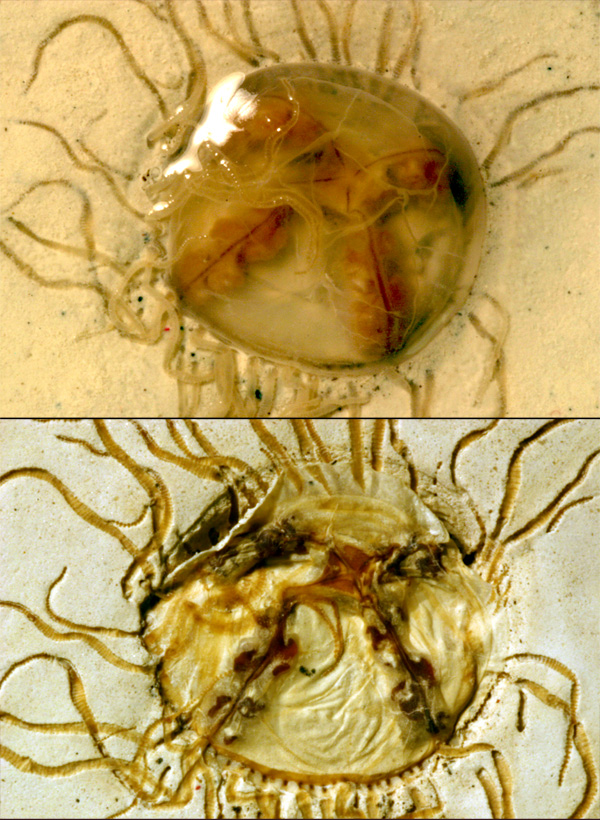
A preserved specimen of the modern hydromedusan jellyfish Gonionemus, before and after burial and drying in lime mud. Note how different structures are modified by the drying process. Although this is somewhat analogous to jellyfish fossilization, a chemically preserved jellyfish such as this does not really rot, whereas most fossil jellyfish show evidence of considerable decomposition, and tend to have lost structures such as tentacles.
Live medusae pump their bells (bodies) in attempting to escape stranding on the shore; this can cause them to take in considerable amounts of sediment. As a result of this behaviour, fossil jellyfish can show raised sediment mounds in the mouth area, moat-like depressions near the bell margins, and/or globe-shaped internal moulds. A dead jellyfish on the shore will dehydrate and shrink, resulting in wrinkles or fissures.
When most people think of jellyfish, they think of tentacles. But tentacles disappear early in decomposition. Fossil medusae rarely have recognizable tentacles, with two notable exceptions. They are more likely to be preserved in members of groups that have particularly thick and tough tentacles in life, such as cubozoans, and they may be more commonly observed in material from certain Konservat-lagerstätten where fossils are preserved as external impressions of soft tissues (such as the Mazon Creek of Illinois). Although impressions of radial canals may also be visible, tentacles and oral arms are never oriented in a perfectly radial pattern when medusae come to rest on or are buried in sediment. Instead, they are usually spread or tangled like the head of a mop.
Jellyfish can fossilize as moulds, or the outer or inner soft tissues can actually be mineralized (the latter is probably rarer). With mouldic preservation, any one specimen will show some structures but not others, depending whether it represents an upper or lower surface, or internal structure. This means that mouldic material can only be understood through the study of multiple specimens.

Laotira is a "classic" medusoid that is now considered to represent a "non-jellyfish." It was described by Walcott from the Cambrian of Alabama, but has since been re-interpreted as a burrow structure. (Field Museum of Natural History specimens)
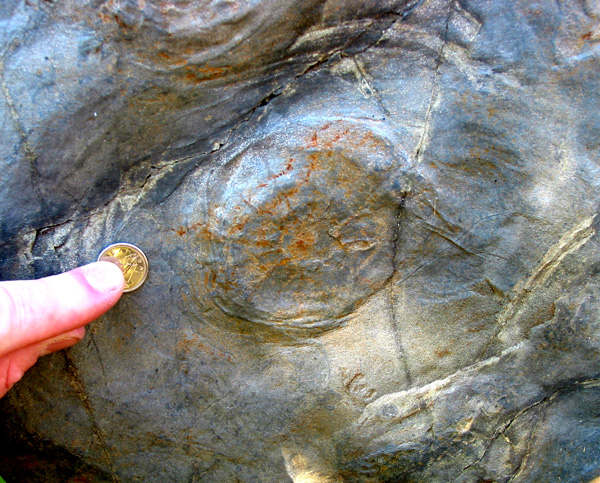
These "jellyfish" in Cambrian rocks in Saint John, New Brunswick, are now interpreted as gas escape structures.
Considering the issues noted above, we can list several criteria that can be used to identify genuine fossil jellyfish:
1. They show evidence of original morphology consistent with having been medusae.
2. They are almost never show perfect radial symmetry, nor are they always oriented parallel to, or on top of, a single bed surface.
3. They may show evidence of transport, deformation, tearing, and/or desiccation.
4. Sites at which medusae are found have paleoenvironmental characteristics consistent with the deposition and preservation of jellyfish. They often occur in conjunction with marine shoreline features in paleoenvironments that may have been hypersaline (very salty) or brackish. There is often evidence of microbial layering or binding of sediments.
5. Genuine medusae often occur on many different horizons (levels) within a deposit, often with dozens to thousands of specimens on individual surfaces.
6. They cannot be easily assigned to other categories of features, such as scratch circles, gas release structures, non-medusan body fossils, trace fossils, evaporite pseudomorphs, archaeological etchings, or inorganic concretions.
The nine deposits that contain definite fossil medusae include:
1. Mid Cambrian (Series 3); Burgess Shale; Mount Field, British Columbia, Canada
2. Mid Cambrian (Series 3); Marjum Formation; House Range, Utah, USA
3a. Mid Cambrian (Series 3); Elk Mound Group; Mosinee, Wisconsin, USA
3b. Mid Cambrian (Series 3); Potsdam Group; Ausable Chasm, New York, USA; Havelock, Quebec, Canada
4. Upper Ordovician; Stony Mountain Formation; William Lake, Manitoba, Canada
5. Upper Carboniferous; Carbondale Formation; Essex & Astoria, Illinois, USA
6. Upper Carboniferous; Cherryvale Formation; Limekiln Hollow, Iowa, USA
7. Lower Triassic; Grès à Voltzia Formation; Vilsberg & Arzviller, Vosges Septentrionales, France
8. Upper Jurassic; Cerin Lithographic Limestone Formation; Cerin, Jura Mountains, France
9. Upper Jurassic; Solnhofen Formation; S. Franconian Alb, Bavaria, Germany
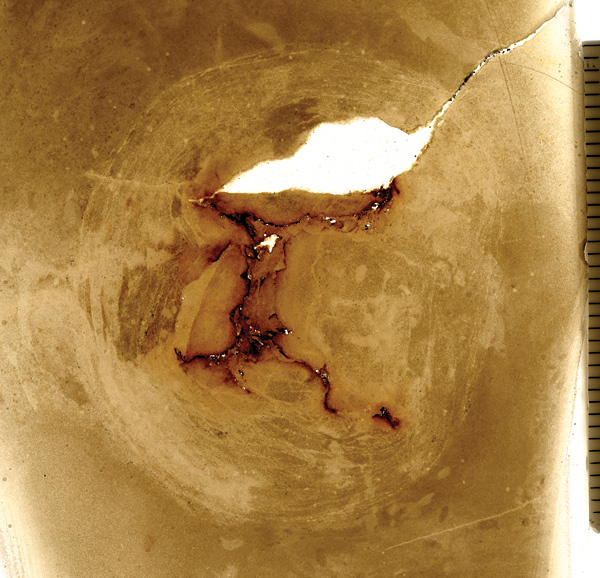
This thin section through one of the William Lake jellyfish illustrates how fossil jellies can possess anatomy comparable to that of modern medusae. Compare this with the dried Gonionemus above. Scale is in millimetres. (The Manitoba Museum, MM I-4262b)
Whitey Hagadorn and I are currently evaluating additional likely occurrences of fossil medusae, but we would be delighted to find out about other deposits that might add to the list. Please send photos if you have found fossils that seem to meet the “jellyfish criteria”!
© Graham Young, 2010


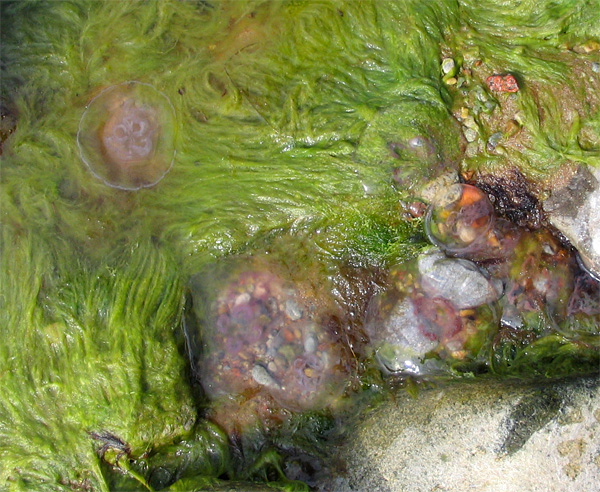
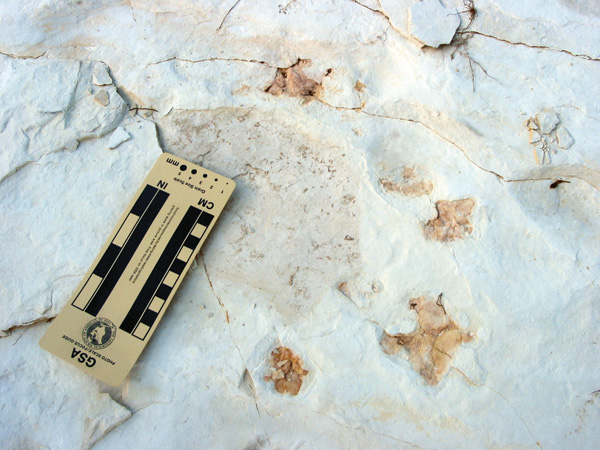

Hi Graham:
Thanks for the handy guide on jellyfish fossils… I will be on the lookout for Silurian Jellyfish at the Ontario sites next year… I did see and photographed a black radial symmetry blob like fossil that was collected by the ROM team this fall.. potential jellyfish??? Not sure…. only time will tell as they are studying it….
Best Regards,
Peter Lee
Thanks Peter. Was that in the Eramosa? And did Peter von Bitter collect the specimen?
Hi Graham:
Yes and PvB had car troubles and could not make it that day. The fossil was cut out by Stu for PvB. I sent copies of the pictures taken that day to PvB, Stu and Dave R. It would not be appropriate to publish any pictures from that site here for obvious reasons as I deem the images belong to the property of ROM…. I was just a guest that day…. a very special day indeed.
PL
I think I have found two fossil jellyfish in Spanish Miocene, but I’m not very sure. They were found in a layer where there are also stromatolites, for example, but any other macroscopic fossils due to the high salinity of the water in that moment.
If you want some pics, don’t heasistate to ask.
Greetings!
I would love to see photos of those. So far in the Cenozoic/Paleogene we only have one possible fossil jellyfish occurrence, so it would be really good to know about others!
Ooooh, so you’re telling me I’ve been to over 10% of the currently known (and accepted) global fossil jellyfish localities? Fantastic, this is going in my memoirs.
Also, I was just wondering why your 3rd fossil jelly deposit was split into two, and not listed as two separate deposits? I’m not exactly up on my Mid Cambrian stratigraphy, but are the Elk Mound and Potsdam groups equivalent?
Hey Matt, thanks again for all your help last summer! At the moment you have been to over 10%, but there are actually several additional deposits that seem likely once they have been investigated a bit more.
Yes, Whitey considers the Potsdam and Elk Mound to be pretty much equivalent, plus they are extremely similar in terms of preservation and depositional environment, so he thought it made sense to consider them as “sub-deposits.” The other pair that could, conceivably, be linked are the Jurassic lithographic limestones: the Cerin and Solnhofen.
Hi Graham,
My name is Mario Lacelle and I am a big fan of your blog. I was actually involved in the discovery of the medusa bearing horizons in Havelock, Qc. Since then, we have discovered 2 more deposits in Northern New-York. I will shortly be doing fieldwork there on behalf of YT Hagadorn. I will keep you posted.
Mario, many thanks for your comment! I will look forward to your progress with the Quebec material (Cambrian, I am assuming), and I will be talking to Whitey about it too.
Please send me an email address where I might contact you about this without its going on a blog. Thank you,
Could you contact me off-blog? Thank you.
Some forms of medusoids from the Conasauga Shale (Waltcott’s Coosa Valley) have shown characteristics of sponges. See Paleobiology and Geochemistry of Siliceous
Concretions with Trilobites and Brooksella by D Schwimmer.
https://www.google.com/url?sa=t&rct=j&q=&esrc=s&source=web&cd=29&cad=rja&uact=8&ved=0ahUKEwiY7Z6I5KLXAhWs64MKHS–CRo4FBAWCEgwCA&url=http%3A%2F%2Fcsuepress.columbusstate.edu%2Fcgi%2Fviewcontent.cgi%3Farticle%3D1867%26context%3Dbibliography_faculty&usg=AOvVaw3ty3__le_d6pf2GNTFx3Nd
Hi Graham (quite later message looking that the post was published in 2010). I’m searching on references about the study on fossil jellyfishes of the Upper Carboniferous Cherryvale Formation. Have you some papers that have studies this soft-bodied fauna to suggest?
Thanks a lot,
Enrico
Hi Enrico, please send me an e-mail about this, as I fear I will forget your comment here. Do you have my e-mail address?
Hi Graham, thank you for your prompt reply.
Yes, I have your email (I’ve contacted you last September concerning the request for some pictures of the Manitoba’s jellyfish).
Meanwhile I’ve found yesterday the paper (Ossian, 1973) that describe these Pennsylvanian scyphomedusan… If there are other papers concerning these medusae I’ll be happy to have updates, otherwise I’ve solved my quest.
Wish you a good day,
Enrico
Thanks, Enrico. We are currently working on some Carboniferous jellies, including Ossian’s material, so there will be updates at some point. But not quite yet!
Hi Graham I have definitely found a well defined jellyfish in New Mexico, Usa and was wondering if you could identify it for me because I could not find any similar specimens on record.
If you contact me I will be able to send you pictures. I also noticed that it is on its side insted of the traditional top view which is more common.
Hi Jackson, that is very interesting. I will send you an e-mail at the contact listed.